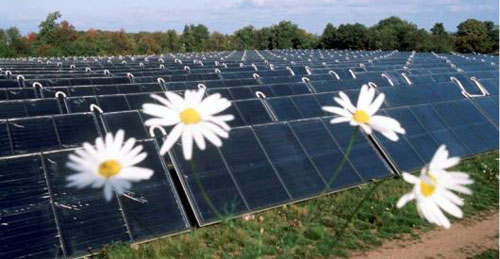San Francisco based Cleantech to build world's largest solar power plant in California.
 Other News
Other News Subscribe to newsletter
Subscribe to newsletter
| 11 Jul 2007 |
Kings River Conservation District (KRCD) and Cleantech America, LLC, has announced that they have entered into a multi-year agreement for Cleantech America to provide up to 80 megawatts of utility scale, emission-free, peak solar power to the recently formed San Joaquin Valley Power Authority (SJVPA).
Under the plan, KRCD and Cleantech would develop renewable solar energy for the Authority's Community Choice customers throughout the San Joaquin Valley. Upon full build-out, KRCD's Community Choice Solar Farm would be the nation's largest utility scale photovoltaic facility by far providing reliable, cost effective green energy to Central Valley residents and businesses using Community Choice power.
The memorandum of understanding calls for the facility to be developed in phases of 10 megawatts in 2009, 30 megawatts in 2010 and 40 megawatts in 2011, for a total of 80 MW. Currently the largest announced facility in the U.S. is a 15 MW solar plant at Nellis Air Force Base in Nevada. Cleantech America last week announced an agreement with PG&E for a 5 MW solar farm, CalRENEW-1, which also will be located in Fresno County, and will be the third largest photovoltaic facility in the Country and the largest in California.

Solar electricity on this scale would have significant beneficial, environmental, and economic impacts for the region. At full build-out, the 80 MW solar farm would avoid over 100 million pounds of CO2 emissions annually. Based on results from a UC Berkeley jobs creation survey, an 80 MW facility would create up to1,040 installation / maintenance job-years in the local area and up to 1,600 manufacturing job-years (a portion of which will be in the local area).
The SJVPA was formed in 2006 pursuant to a Joint Powers Agreement for the purpose of implementing a community choice aggregation program for the greater Fresno area of the San Joaquin Valley. California Assembly Bill 117, passed in 2002, allows cities and counties to combine the electrical loads of their constituents for bulk electricity purchases. The Authority is currently comprised of 12 member cities, as well as Tulare and Kings counties. Management of the Authority is under the direction of KRCD, which will include the procurement of generation to supply the participating customers.
"The promise of Community Choice is to have local control of our energy destiny. This means providing a choice of energy providers, stable and predictable rates, and valued added to the region through the development of new, local renewable energy sources like utility-scale photovoltaic solar which is generated within our service area, close to our energy load. Developing 80 megawatts of clean energy from the sun would take us a long way to achieving these goals while demonstrating the value of Community Choice," said David Orth, General Manager of KRCD.
Bill Barnes, CEO of Cleantech America LLC., said, "This is a visionary step by Kings River Conservation District. The extraordinary economies of scale which can be achieved by facilities of this magnitude would have a dramatic effect on helping solar energy achieve grid parity. Solar on this scale would unquestionably attract many solar manufacturing, fabrication and related jobs to the San Joaquin Valley, and further promote the region's growing image as California's 'Solar Valley.' And because in-grid zero emission solar provides peak power when it is needed most, during the hottest times of day during the hottest times of the year, it supports increased generation reliability in the region."
The San Joaquin Valley's potential for PV solar is enormous because of its great sun characteristics. PV solar is a natural fit for the Valley because it can be sited in-grid to generate clean energy close to where the power is needed directly for the benefit of those communities - areas that have long suffered from poor air quality. Many other renewables, like solar thermal and wind, have to be sited far away, and often require construction of expensive new transmission. In-grid PV solar is local-based and directly benefits the communities it serves in multiple ways.
The beneficial air quality impacts of the plan are significant. At full build-out, the 80 MW solar farm will avoid over 100 million pounds of CO2, over 87,000 pounds of SO2, over 110,000 pounds of ozone-forming NOx, and over 450 pounds of toxic mercury emissions annually [based on U.S. Environmental Protection Agency data for California's power grid (CAISO)]. The avoided climate change emissions are the equivalent to removing over 20,000 cars from the road.




